Before 1940, women made vital yet often unrecognized contributions to chemistry, from Agnes Pockels’s surface tension studies to Ida Noddack’s nuclear fission proposal. Pioneers like Elizabeth Blackwell and Rachel Lloyd broke barriers in medicine, while Isabella Karle’s work advanced structural chemistry. Many faced social hurdles but persisted, transforming science and industry. If you explore further, you’ll discover how these trailblazing women shaped the foundations of modern chemistry and broke societal barriers.
Key Takeaways
- Agnes Pockels and Alice Ball made groundbreaking contributions in surface chemistry and medicinal chemistry, despite limited recognition during their time.
- Women like Rachel Lloyd and Ida Freund broke educational barriers, earning Ph.D.s and university teaching positions before 1940.
- Pioneering women in crystallography, including Rosalind Franklin and Dorothy Hodgkin, advanced structural understanding of biomolecules.
- Medical trailblazers such as Metrodora, Elizabeth Blackwell, and Mary Jacobi challenged societal norms, shaping modern medicine and pharmacology.
- Despite societal obstacles, women like Ellen Swallow Richards and Kathleen Lonsdale profoundly influenced environmental and industrial chemistry.
Trailblazers in Surface Science and Early Chemical Discoveries
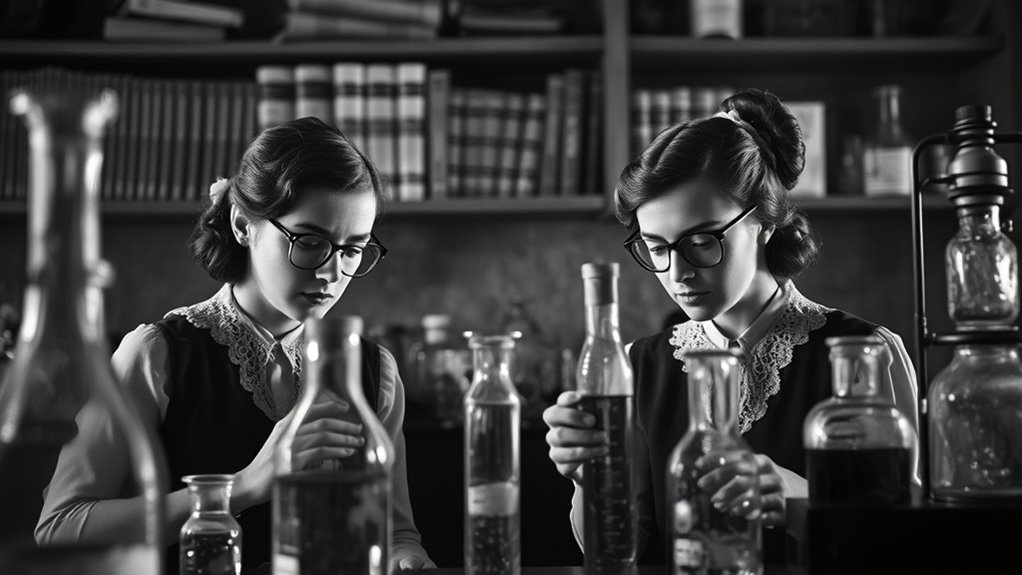
Trailblazers in surface science and early chemical discoveries laid the foundation for many modern scientific advancements. Agnes Pockels, working without a formal position, developed simple yet effective equipment to measure surface tension accurately. Her meticulous experiments uncovered essential insights into molecular interactions at liquid-air interfaces, influencing future surface chemistry studies.
Alice Ball made groundbreaking progress in medicine by isolating active compounds from chaulmoogra oil, creating the first effective injectable leprosy treatment. Despite institutional barriers, she worked as a chemistry instructor while advancing her research, saving countless lives.
These women’s innovative techniques and discoveries, often made independently, profoundly shaped physical and applied chemistry. Their pioneering efforts set fundamental groundwork, demonstrating that even without formal recognition, perseverance and ingenuity can transform scientific understanding.
Breaking Barriers in Education and Academic Recognition
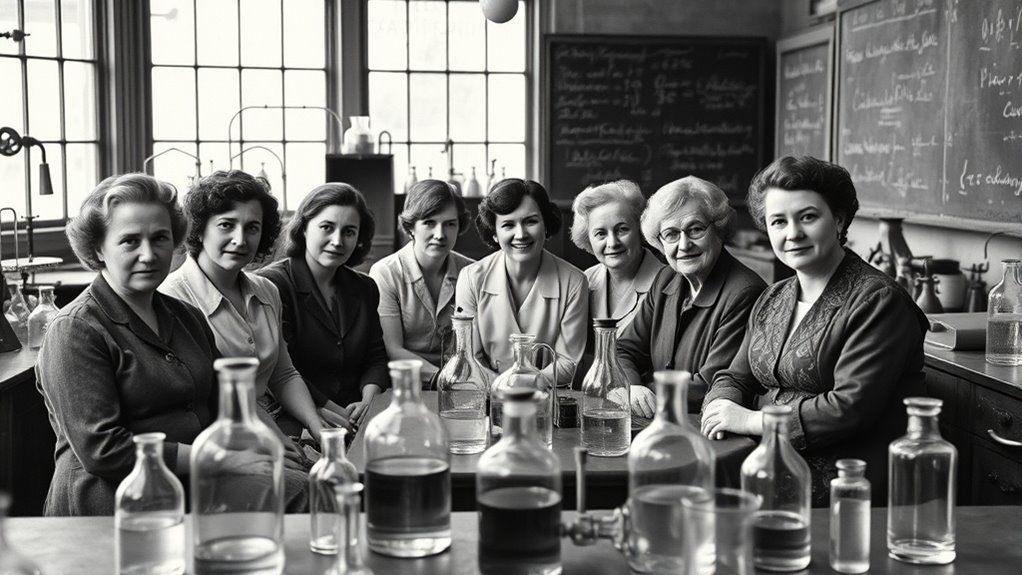
Despite longstanding societal and institutional barriers, women have made significant strides in gaining access to higher education and professional recognition in chemistry.
Women have overcome barriers to achieve recognition and success in chemistry.
In 1898, Bedford College in the UK hired Barbara Tchaykovsky as its first woman chemist assistant lecturer, breaking ground for female academics. Schools like North London Collegiate School for Girls began integrating science into their curricula, nurturing future female scientists.
Rachel Holloway Lloyd became the first American woman to earn a Ph.D. in chemistry, setting an important precedent. Ida Freund became the UK’s first female university chemistry lecturer in 1890, challenging norms.
Despite societal skepticism, women persisted, earning doctoral degrees and securing teaching roles. Their efforts gradually shifted academic standards, opening doors for women to participate fully in chemistry education and research.
Pioneers in Crystallography and Structural Chemistry
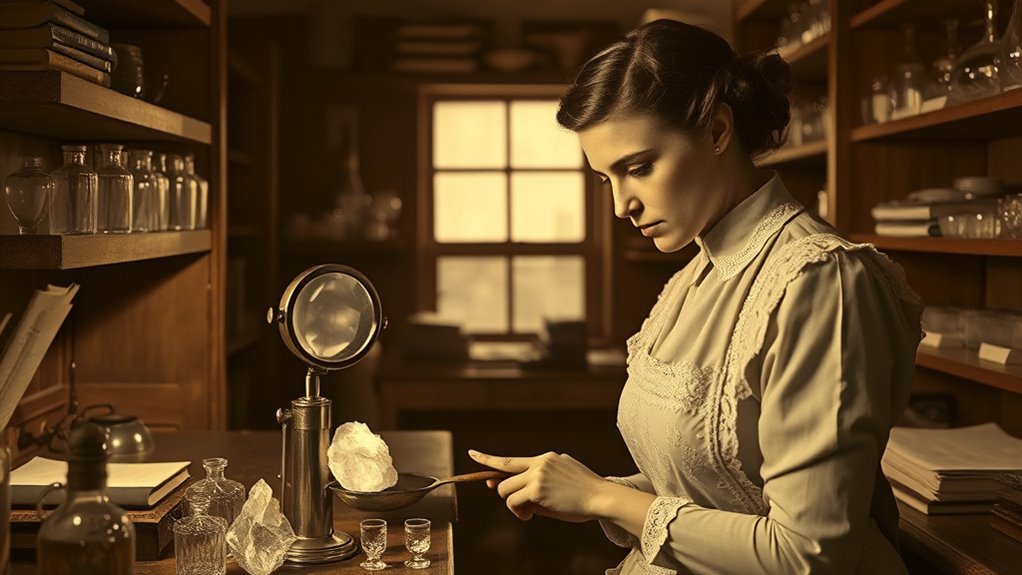
Women have made remarkable contributions to the field of crystallography and structural chemistry, shaping our understanding of molecular structures. Although many breakthroughs occurred after 1940, early researchers laid essential foundations. A key aspect of their success was their dedication to creative practice, which allowed them to develop innovative methods and solve complex problems. Their perseverance in the face of societal barriers enabled them to make groundbreaking discoveries that continue to influence the field today. Pioneers like Isabella L. Karle advanced electron diffraction techniques and tackled the phase problem, profoundly impacting structural determination. Rosalind Franklin’s work with X-ray crystallography provided critical insights into DNA’s structure, influencing modern genetics. Dorothy Hodgkin’s early efforts in X-ray crystallography set the stage for later biomolecular discoveries.
These women faced societal and institutional barriers but persisted, developing tools and methods that transformed chemistry. Their work helped reveal the three-dimensional arrangements of molecules, influencing fields from biochemistry to materials science. The importance of technological innovation in their discoveries highlights the role of emerging tools in scientific progress. Their contributions remain crucial, inspiring future generations to push the boundaries of scientific understanding.
Women Who Changed Medicine and Pharmacology
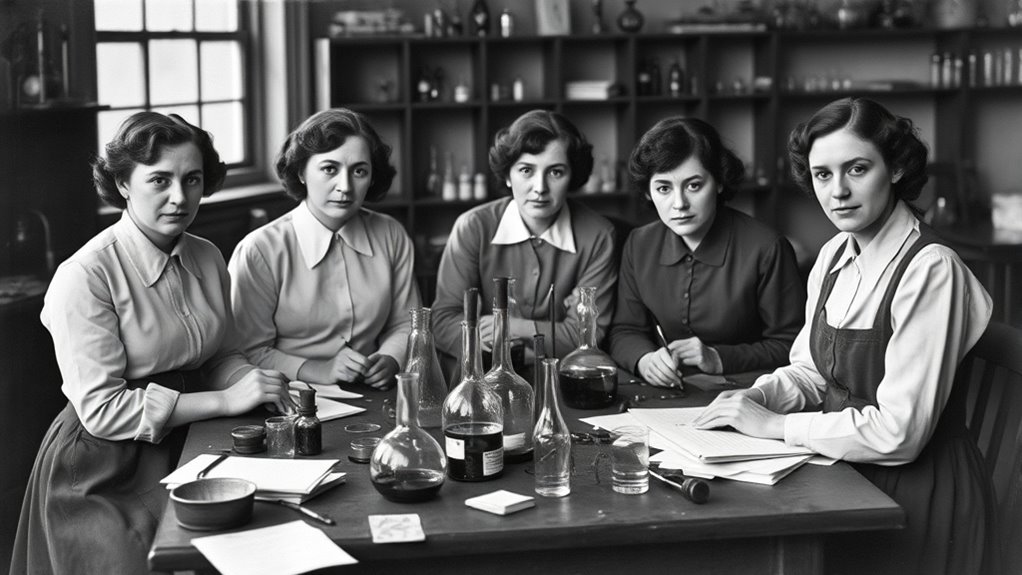
Have you ever wondered how the field of medicine and pharmacology was transformed by those who challenged societal norms? Women like Metrodora, in 7th-century Greece, pioneered early treatments for uterine and breast cancers.
Louise Bourgeois, a French midwife, authored the first obstetrics book by a woman, documenting over 2,000 deliveries in the early 17th century.
Elizabeth Blackwell broke barriers as the first woman to earn a U.S. medical degree in 1849, inspiring future generations.
Mary Jacobi became the first woman to graduate from a U.S. pharmacy college in 1863, paving the way for women in pharmacy.
Despite facing discrimination, these women pushed boundaries, contributed to medical texts, and helped establish women’s roles in medicine and pharmacology, leaving a lasting legacy of innovation and resilience.
Understanding industry trends aids in appreciating how these pioneers navigated changing perceptions and advancements in their fields.
Advancements in Industrial and Environmental Chemistry

Advancements in industrial and environmental chemistry have been profoundly shaped by the pioneering efforts of women scientists. Ellen Swallow Richards led the way by applying chemistry to sanitation, improving water quality, and promoting urban health reforms. Her work laid the foundation for modern environmental standards and public health initiatives. Her innovative approaches to water testing and analysis influenced the development of water quality testing methods, which remain vital today. She also emphasized the importance of sustainable resource management, highlighting her forward-thinking approach to environmental challenges. Ida Eve Noddack proposed nuclear fission in 1934, laying groundwork for nuclear energy. Ruth Rogan Benerito developed textiles with better wrinkle resistance, transforming the post-WWII cotton industry. Kathleen Lonsdale advanced X-ray crystallography, essential for industrial synthesis, while Anna Sundström contributed to early industrial chemical processes. Margarete Traube studied water and air pollution, influencing environmental standards. Mary Engle Pennington improved food preservation, enhancing public health. These women’s innovations in analytical techniques, safety protocols, and environmental health have considerably propelled industry and ecological progress.
Overcoming Obstacles: Recognizing the Legacy of Women Chemists
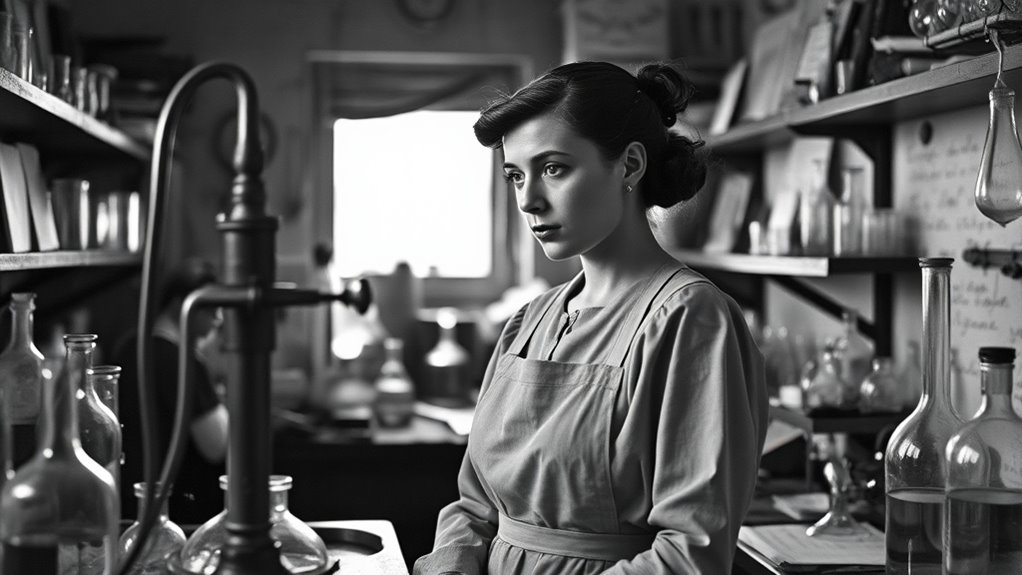
Despite significant contributions to industrial and environmental chemistry, many women scientists faced formidable barriers that obscured their legacies. Formal bans limited their access to university programs and faculty roles, while social norms confined them to domestic roles, restricting funding and opportunities. Many women had to work unofficially or under male supervisors, receiving little recognition, and scientific organizations often excluded them from networking and publishing. For example, Alice Ball’s groundbreaking work on leprosy treatment was claimed by a male colleague after her death. Additionally, the gender disparities in scientific recognition persisted well into the 20th century, making their achievements even more remarkable. Yet, women like Marie Curie, Alice Ball, and Ida Freund broke barriers, earning Nobel prizes, pioneering research, and shaping academic institutions. Their perseverance challenged gender norms and laid the groundwork for future generations, ensuring their contributions are finally recognized and celebrated. Additionally, the emergence of remote hackathons offers new avenues for diverse participation, helping to empower underrepresented groups in STEM fields.
Frequently Asked Questions
How Did Female Chemists Navigate Male-Dominated Scientific Communities Before 1940?
You learn that female chemists before 1940 navigated male-dominated communities through persistence, resilience, and strategic collaborations. They often worked with supportive male colleagues, engaged in self-study, and joined professional societies to build networks.
Some relied on patronage from influential figures to access resources. Despite societal barriers, their determination and independent research helped them gain recognition and make significant contributions to chemistry.
What Specific Challenges Did Women Face in Publishing Their Research During This Era?
You face many barriers when publishing research during this era. Gender bias in journals and scientific societies makes acceptance difficult, while limited access to funding and facilities restricts your ability to conduct and share experiments.
Societal expectations often force you to prioritize domestic roles, and recognition of your work is minimized or overlooked.
To publish, you might have to use male pseudonyms or publish in lesser-known outlets, further hindering your visibility.
Were There Notable Differences in Opportunities Between Women in Academia Versus Industry?
You notice that women in academia faced more limited opportunities than those in industry during this era. Academia offered few positions, with gender bias and stereotypes blocking career advancement.
In contrast, industry provided more employment options, especially during wartime, but women often earned lower pay and had limited growth prospects.
How Did Early Female Chemists Influence Subsequent Generations of Women Scientists?
You see, early female chemists paved the way for future women scientists by breaking gender barriers and proving success is possible. Your role models showed perseverance, inspiring new generations to pursue education and careers in chemistry.
Their achievements in research, teaching, and leadership challenged stereotypes, opening doors for women worldwide. Their legacy encourages you to continue advancing gender equality and make your own mark in science.
Which Organizations or Movements Supported Women’S Advancement in Chemistry Before 1940?
Think of these organizations as bridges, helping women cross into the world of chemistry. The Russian Chemical Society welcomed Anna Volkova in 1870, and the American Chemical Society opened doors in 1876.
Women’s colleges, government labs, and universities supported education and research. Networks like professional associations and mentorship programs grew, empowering women to break barriers despite societal norms, shaping future generations of women scientists.
Conclusion
You might think women chemists before 1940 were just quietly working in shadows, but they actually laid the foundation for modern science. Ironically, their groundbreaking discoveries often went unrecognized, overshadowed by the very barriers they fought to break. As you reflect, remember that without their quiet perseverance, many of today’s innovations might still be hidden behind closed doors. It’s a reminder that history often forgets its true heroes—until someone finally gives them the spotlight.









